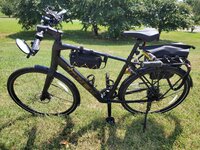So I have to say.. I really really like the FX+2 and would already consider it easily the best under 45lb (XL weights 41lbs), ebike that's also under 3k.. and would actually make for a pretty good fitness bike if you get the Dual Sport without the extra weight (fenders, rack, remove kickstand). It pedals as easy as the Vado SL imo (at least in the XL), the motor feels slightly more powerful on the moderate hills ive tried, and you barely feel the motor move from pedal assist at under 20mph to 20+mph. It's silent, can be pedaled off-motor with zero resistance; zero creaks, whines etc. The gearing is mostly sufficient, and it just feels quality. The saddle is also surprisingly comfortable.
The main issue though is something that should probably be addressed by Trek, is that.. as Richard Stallard mentioned.. The pedal sensor is not a torque sensor as is advertised, it's clearly a cadence sensor. It's a pretty good one, but it isn't as smooth as a torque sensor at all, as its mainly and clearly noticeable when starting from a stop.. so the riders who are purchasing for that reason are likely to be pretty disappointed. But it is otherwise a fanTASTIC bike at any budget if you don't mind hub motors and cadence sensors. I also tried to install the Hyena Rider App (android) and it would not sync with the bike. Not sure what the issue would be, and there isn't a display to check for additional settings. Fwiw the battery also seems really good in the short time ive ridden thus far.
Areas of improvement:
Bike should have an actual torque sensor as advertised
Hyena Rider App should be standardized and easily syncable with the bike
I actually like the minimalist controller but should have an option for display, even 3rd party (garmin etc. and maybe it is possible)
Comes with 42T chainring which is sufficient on the FX+2 imo, but the Dual Sport should have a factory option to fit a 46t+ (per Trek this is possible, however they couldn't provide options).
Personal preference: Should have the ability to unlock pedal assist in software to 24-28mph (
Aventon Soltera 7 has this on its hub motor)
Also, to be clear.. The Vado SL would still be considered a better bike imo. The only downsides of that bike would be the occasionally audible/low buzz of the motor, but it rides exactly like a normal bike in my experience and the torque sensor is seamless. The FX+/Dual Sports are just really good values with some compromises.
Edit: FWIW Took this hill no problem on 3 bars and some effort on 2 bars. Not sure the grade, but its as steep as it looks (or steeper than it looks lol)

